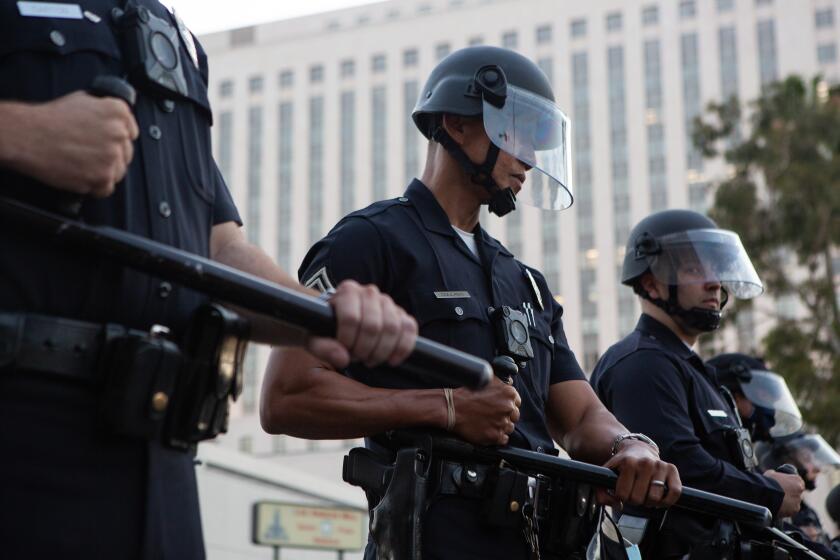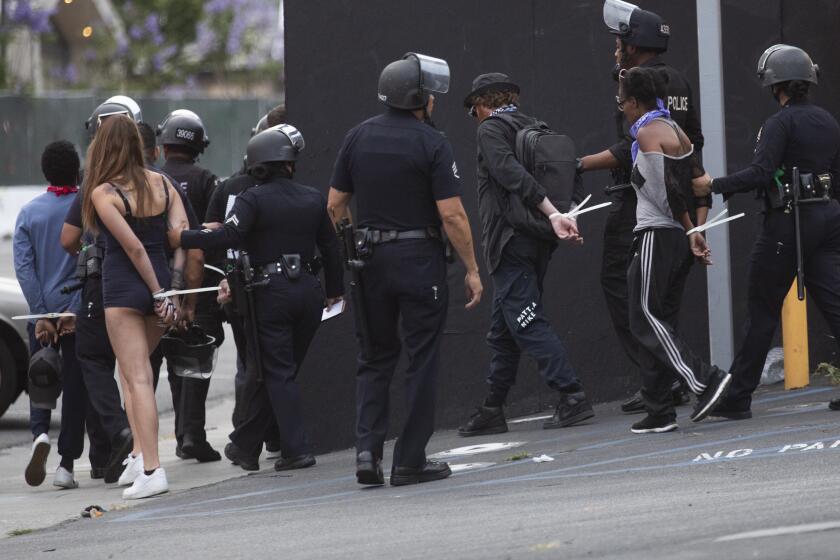A high-stakes moment for LAPD as city braces for verdict in Derek Chauvin trial

- Share via
When George Floyd died after a Minneapolis police officer knelt on his neck nearly a year ago, the Los Angeles Police Department’s response to widespread protests and pockets of unrest prompted harsh criticism, a raft of lawsuits and scrutiny both inside and outside the department.
Now, with a verdict in the murder trial of former Minneapolis Officer Derek Chauvin looming and the potential for more protests, the LAPD faces a major test of whether it can improve tactics as promised.
Three separate reviews of the LAPD’s response to the protests of the last year, each released in the last few weeks, found that Moore and other LAPD leaders failed to prepare for such large-scale, diverse demonstrations; failed to train officers on how to handle such events or use the projectile weapons they were given; failed to stand up appropriate procedures for processing the thousands of people they arrested; and contributed to the chaos by issuing confusing and at times contradictory commands to officers in the field.
The reports were particularly critical of LAPD leadership, rather than individual officers, and activists have called for Los Angeles Police Chief Michel Moore to be fired for his role.
Moore on Monday said his department is prepared to respond to any potential unrest following a verdict in the Chauvin trial, would have significant numbers of officers on the ground in the event of major gatherings and would be utilizing lessons learned from last year to ensure that order is maintained.
“Those added resources are already in play,” Moore said. “Our entire department is in uniform.”
In addition to enhanced deployments, the department has said it has retrained thousands of officers in crowd-control tactics since last year and streamlined processes for arresting, transporting and booking large numbers of demonstrators in a fair and efficient manner.
But as the LAPD unveiled its plans Monday, a federal judge placed new restrictions on the department’s use of hard-foam projectiles to clear unruly crowds.
U.S. District Judge Consuelo B. Marshall’s order came at a high-stakes moment for the LAPD and for Moore personally after a year of introspection and criticism over how the department — and particularly its leaders — handled the protests and unrest that erupted in L.A. after Floyd’s death last spring.
The case captured international attention after video showed Chauvin kneeling on Floyd’s neck for more than nine minutes as Floyd begged for air, sparking protests across the nation and globe. In L.A., tens of thousands of people marched in the street; others burglarized and burned stores and businesses amid the chaos, and police made thousands of arrests as officers clashed with demonstrators along skirmish lines and curfews went ignored.
Two more reviews have found glaring problems with the Los Angeles Police Department’s handling of last summer’s mass protests against police brutality.
Now, with much about last year’s unrest still unresolved, another potential challenge looms. Prosecutors and Chauvin’s defense team gave closing arguments Monday in the Minneapolis trial, leaving the case in the hands of the jury.
In a joint town hall event with L.A. County Sheriff Alex Villanueva on Monday afternoon, Moore said the LAPD will facilitate the peaceful airing of frustration or anger if protesters don’t like the verdict and decide to take to the streets, but the department will not tolerate violence or destruction.
Moore’s assurances came on the same day Marshall granted a temporary restraining order restricting the LAPD’s use of hard-foam 37-millimeter and 40-millimeter projectiles. The order came in a case in which Black Lives Matter Los Angeles and other activist groups are suing the LAPD over its response to last year’s protests.
Marshall found that the activists had successfully shown that they would face future “irreparable injury” from the weapons, including at expected protests following the Chauvin verdict, if the court didn’t immediately intervene. Marshall cited evidence that the LAPD has used such projectiles “on protesters who do not appear to be violently resisting or posing an immediate threat of violence or physical harm.”
A lawsuit alleging violent abuses of power by L.A. police during recent protests now includes more details on injuries suffered by demonstrators.
Her ruling establishes guidelines for the weapons — such as not targeting people who don’t represent a physical threat and not shooting people in the face or head — that mirror existing LAPD policies that officers appear to routinely violate.
Carol Sobel, an attorney for the activist groups, said the restraining order was the result of a “massive amount of evidence” the groups submitted showing people being shot in the head, chest and upper body, “despite the LAPD’s claim it does not do that.”
The Times has found that LAPD officers appeared to violate the rules last year during an unruly gathering downtown after the Lakers’ championship victory in October and during a recent protest over the clearing of a homeless encampment around Echo Park Lake.
Moore did not immediately respond to a request for comment on Marshall’s order but has said previously that the department has been working to better train officers on such weapons and scaled back their use at recent protests, including the one in Echo Park.
During a Police Commission meeting last week, Lizabeth Rhodes, director of the LAPD’s Office of Constitutional Policing and Policy, responded to a question about whether the 40-millimeter weapons should be banned in protest settings by saying they were needed to “direct at those rogue members” causing trouble in crowds.
LAPD used violence to quell protests over police brutality, using batons and ‘less lethal’ bullets in ways that probably violated protocols.
Next week, LAPD officials are meant to present to the Police Commission a plan for implementing additional reforms based on the recommendations of the three recent after-action reports.
Critics of the department have said they are skeptical of the promises of reform and unconvinced that additional resources will translate into more constitutional policing. They say such promises have been broken before.
Isaac Bryan, executive director of the UCLA Black Policy Project, said the fact that discussion of the LAPD’s crowd-control policies comes at the same time as the Chauvin trial creates “a pretty powerful intersection” that deserves scrutiny within the broader context of the LAPD’s history of “protest suppression.”
Bryan said he was struck with batons by police during last year’s protests and watched as people were shot with projectiles after officers demanded protesters leave an area that the officers had intentionally boxed them into. He said the LAPD’s use of such tactics, and showing up to protests in riot gear, is “a form of escalation” that stirs tensions.
“When you escalate a situation that was derived from extreme trauma and sadness and pain and hurt, not only do you dismiss those feelings, but you turn those feelings into outright anger and outrage,” Bryan said.
If Chauvin is acquitted, he said, any violence in the streets will have been “agitated by the way law enforcement responds to people.”
More to Read
Sign up for Essential California
The most important California stories and recommendations in your inbox every morning.
You may occasionally receive promotional content from the Los Angeles Times.

















